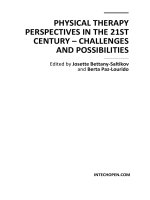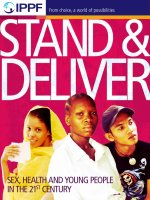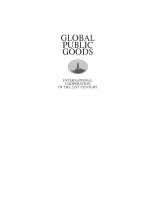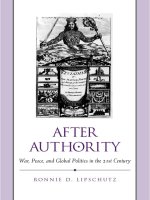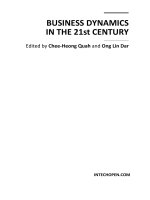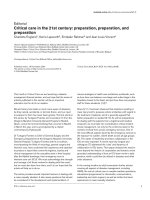Framing work unitary, pluralist and critical perspectives in the 21st century
Bạn đang xem bản rút gọn của tài liệu. Xem và tải ngay bản đầy đủ của tài liệu tại đây (1.35 MB, 331 trang )
OUP CORRECTED PROOF – FINAL, 5/8/2016, SPi
F R A M I N G WO R K
OUP CORRECTED PROOF – FINAL, 5/8/2016, SPi
OUP CORRECTED PROOF – FINAL, 5/8/2016, SPi
Framing Work
Unitary, Pluralist, and Critical Perspectives
in the Twenty-first Century
EDMUND HEERY
1
OUP CORRECTED PROOF – FINAL, 5/8/2016, SPi
3
Great Clarendon Street, Oxford, OX2 6DP,
United Kingdom
Oxford University Press is a department of the University of Oxford.
It furthers the University’s objective of excellence in research, scholarship,
and education by publishing worldwide. Oxford is a registered trade mark of
Oxford University Press in the UK and in certain other countries
© Edmund Heery 2016
The moral rights of the author have been asserted
First Edition published in 2016
Impression: 1
All rights reserved. No part of this publication may be reproduced, stored in
a retrieval system, or transmitted, in any form or by any means, without the
prior permission in writing of Oxford University Press, or as expressly permitted
by law, by licence or under terms agreed with the appropriate reprographics
rights organization. Enquiries concerning reproduction outside the scope of the
above should be sent to the Rights Department, Oxford University Press, at the
address above
You must not circulate this work in any other form
and you must impose this same condition on any acquirer
Published in the United States of America by Oxford University Press
198 Madison Avenue, New York, NY 10016, United States of America
British Library Cataloguing in Publication Data
Data available
Library of Congress Control Number: 2016931573
ISBN 978–0–19–956946–5
Printed in Great Britain by
Clays Ltd, St Ives plc
OUP CORRECTED PROOF – FINAL, 5/8/2016, SPi
To Janet, Catherine, and Patrick
OUP CORRECTED PROOF – FINAL, 5/8/2016, SPi
OUP CORRECTED PROOF – FINAL, 5/8/2016, SPi
Preface
The origins of this book lie ten years ago when I co-authored the Introduction
to the Sage Handbook of Industrial Relations (Heery et al. 2008). In the
Introduction, I and my co-authors identified the main ‘normative orientations’ within Industrial Relations (IR) and briefly reviewed the debate between
them. A dominant pluralist frame of reference, we argued, had been subject to
powerful critique by Marxism, feminism, and neo-liberalism from the 1970s
onwards and had responded, partly through the development of countercritique and partly by seeking an accommodation with critics. In the latter
case, mainstream IR adjusted to critique by absorbing some of the assumptions and systems of argument of its opponents. The book springs from this
seed and the conviction born at the time that it was possible to write an
account of IR that made use of the time-honoured concept of frames of
reference.
The book’s first purpose, therefore, is to demonstrate the continued utility
of the frame-concept by showing that there are unitary, pluralist, and critical
currents within IR broadly defined and that much contemporary writing on
employment can be allocated to one of these three traditions. Unitary, pluralist, and critical frames have evolved away from classic positions, as developed in the early years of the field, it is argued, but they are enduring and
remain identifiable today. A second purpose is to examine the interaction
between these three frames of reference. The book is distinguished by an
attempt to identify the lines of fracture within IR as a field of study, rather
than common assumptions that bind disparate traditions together, and to this
end it examines several areas of current debate between unitary, pluralist, and
critical researchers. These areas are worker participation, consumer culture,
equality and diversity, and the impact of the global financial crisis on employment relations in developed economies. In all of these areas, the book identifies unitary, pluralist, and critical argument and notes the lines of contention
that divide these positions and the sometimes surprising accommodation that
occurs between them.
In writing the book I have received considerable help from friends and
colleagues. Peter Ackers, Paul Edwards, Jean Jenkins, John Kelly, and Tom
Keenoy have each read chapters and provided helpful advice that has contributed to redrafting. In a couple of cases the encouragement received by readers
kept me going when finishing the book seemed a very distant prospect indeed.
Parts of the book have also been presented to seminar and conference audiences at Warwick University, Loughborough University, Saïd Business School
OUP CORRECTED PROOF – FINAL, 5/8/2016, SPi
viii
Preface
in Oxford, and at the Universities of Macquarie, Melbourne, and Monash in
Australia. A version of Chapter Three on pluralism was presented to the
International Labour and Employment Relations Association (ILERA) conference in Cape Town, South Africa in 2015. I am grateful to all who
participated in these events and who provided useful feedback. Especial
mention should be given to Willie Brown who provided detailed written
comments on the South African conference paper. A version of the pluralist
argument has also been published by the Journal of Industrial Relations (Heery
2016). Chapter Three is much longer and different in a number of respects
from the journal article but there is some overlap and I am grateful to the
journal and its editors for their permission to re-use material. Finally, the book
takes the form of an extended literature review and lots of people have
kindly provided me with suggestions for reading, especially in areas where
my prior knowledge was limited. Those who have helped me in this way
include: Peter Ackers, Ismael Al-Amoudi, Peter Armstrong, Rachel Ashworth,
Willie Brown, Andy Danford, Steve Davies, Tony Dundon, Jane Holgate,
Jean Jenkins, Sarah Jenkins, John Kelly, Rebecca Kolins Givan, Jonathan
Morris, Stephen Mustchin, Aoife MacDermott, Joe O’Mahoney, George Tsogas, and Jane Wills. If I have forgotten anyone who should be on this list,
I apologize—‘It’s his age, you know’.
While many have helped me, I am the sole author of the book and all
the errors, infelicities, and miss-steps (of which I’m sure there are many) are
mine alone.
Edmund Heery
2016
OUP CORRECTED PROOF – FINAL, 5/8/2016, SPi
Contents
List of Abbreviations
xi
1. Introduction
1
2. Unitary Perspectives on Work
13
3. Pluralist Perspectives on Work
36
4. Critical Perspectives on Work
70
5. Debating Participation
111
6. Debating the Customer
138
7. Debating Equality
171
8. Debating the Crisis
211
9. Conclusion
242
Bibliography
Index
261
307
OUP CORRECTED PROOF – FINAL, 5/8/2016, SPi
OUP CORRECTED PROOF – FINAL, 5/8/2016, SPi
List of Abbreviations
ACAS
Advisory, Conciliation and Arbitration Service
AMO
Ability Motivation Opportunity
CIPD
Chartered Institute of Personnel and Development
CLS
Critical Labour Studies
CMS
Critical Management Studies
CTU
Chicago Teachers’ Union
EHRC
Equality and Human Rights Commission
GFC
Global Financial Crisis
HPWS
High Performance Work System(s)
HR
Human Resource
HRM
Human Resource Management
ICE
Information and Consultation of Employees
IEA
Institute for Economic Affairs
ILERA
International Labour and Employment Relations Association
IPRP
Individual Performance Related Pay
IR
Industrial Relations
NGO
Non-Government Organization
NHS
National Health Service
NMW
National Minimum Wage
RBS
Royal Bank of Scotland
RBV
Resource Based View
SEIU
Service Employees International Union
SHRM
Strategic Human Resource Management
TUC
Trades Union Congress
UK
United Kingdom
US/USA
United States of America
USDAW
Union of Shop, Distributive and Allied Workers
VoC
Varieties of Capitalism
WERS
Workplace Employee/Employment Relations Survey
OUP CORRECTED PROOF – FINAL, 5/8/2016, SPi
OUP CORRECTED PROOF – FINAL, 9/8/2016, SPi
1
Introduction
I N T R O D U C TI O N
The workplace is often the subject of controversy. Whether it be the actions of
trade unions, the merits and demerits of a flexible labour market, the impact of
employment law on business, or the impact of private equity investment on
workers, developments at work frequently divide political and public opinion.
These lines of division are echoed powerfully in academic commentary, where
opposed perspectives on work play out a perennial contest of claim and
counter-claim, attack and defence. It is this contest, that is the subject of this
book. Its purpose is to review the academic field of Industrial Relations (IR),
broadly conceived,1 through the rival normative positions that underpin
debate. IR is a field of contending voices, in which unitary, pluralist, and
critical positions clash. In what follows, the characteristics of these perspectives, their contemporary expression, and the arguments between them are
mapped and analysed.
This focus on contention has been missing from other accounts of IR as a
field. These tend to stress IR’s coherence, marked by shared values and
perspectives on the employment relationship (Kochan 1998; Sisson 2008) or
a distinctive methodology (Brown and Wright 1994; Edwards 2005). Where
division is recognized, moreover, its roots are traced to different national
research traditions, which themselves cohere (Frege 2007), or to the influence
of different social science disciplines (Coyle-Shapiro et al. 2005). In fact,
economists, lawyers, psychologists, and sociologists commenting on work
range across the normative spectrum and all of these accounts of IR play
down what to me seems to be its most obvious characteristic; that it is riven
with dispute. Indeed, dispute defines all academic fields. In organization
studies, for instance, there is a veritable Babel of contending voices, making
competing claims about the nature of social reality and the manner in which
researchers can gain knowledge of it (Reed 2006). Meta-theoretical dispute of
this kind is rare within IR. Instead, contention tends to be normative, reflecting the applied, policy-oriented nature of the field. At its heart are competing
assessments of the relative interests of workers and employers, which generate
OUP CORRECTED PROOF – FINAL, 9/8/2016, SPi
2
Framing Work
very different standards for evaluating the real world of work and sharply
contrasting programmes for practical action.
FRAMES OF REFERENCE
Since Alan Fox (1966) used the term in the 1960s, the main perspectives in IR
have been labelled ‘frames of reference’. Fox initially identified two such
frames, the unitary and pluralist frames of reference, although in a celebrated
auto-critique of the 1970s Fox added a third, the radical frame of reference
(Fox 1974: 264–96). The core feature of these frames of reference has been
noted by Budd and Bhave (2008: 93), who state that they consist of ‘packages
of values and assumptions pertaining to the interests of parties to the employment relationship—that is, the needs, wants, and aspirations of employees,
employers, and the state—and the degree to which these interests are compatible’. Thus, in Fox’s classic formulation the unitary frame of reference
regards the employing organization as ‘analogous to a team’ (1966: 1), in
which the shared interests of employer and employee provide the basis for
cooperation at work. The pluralist frame, in contrast, regards the organization
as ‘a coalition of interests that in some respects are divergent’ (1966: 1) and is
concerned with the balancing of interests through systems of conflict resolution. The radical critique of pluralism, for its part, begins from an assumption of fundamentally opposed interests, founded on the exploitation of
workers by the powerful, and regards the accommodation between interests
applauded by pluralists as both fleeting and prone to collapse. Radicals also
regard such an accommodation as undesirable: it reconciles those who are
exploited to their condition, while leaving the structured inequality at the
heart of the employment relationship unchanged (Fox 1974: 279–80).
Fox’s concept of a frame of reference is one of the few within IR that has
passed tests of ubiquity and longevity and it has been applied widely and
continuously by commentators on work since he introduced the term. Application of the concept has followed two broad paths of descent. The first of
these derives from Fox’s use of frames of reference to analyse the ‘ideology
of management’. Fox noted that while managers were embedded in a set of
institutions founded on pluralist principles they themselves often subscribed
to a unitary frame of reference that emphasized shared interests (1966: 5–6).
From this starting point, Fox went on to identify a number of different
‘patterns of management–employee relations’ (1974: 297), which formed the
basis of the subsequent literature on ‘management style’ (Bacon 2008: 244–8).
This term denotes the broad approach that employers adopt to managing
people at work, including underpinning assumptions about the nature of the
employment relationship and the interests that are integral to it. In much of
OUP CORRECTED PROOF – FINAL, 9/8/2016, SPi
Introduction
3
this work a key distinction is drawn between management styles that accept
trade union organization amongst employees and those that oppose it and
which are informed by a unitary frame of reference (e.g. Marchington and
Parker 1990; Purcell and Ahlstrand 1994). The key thing to note, however, is
that Fox’s analysis of frames of reference stimulated attempts to theorize
management beliefs and behaviour. On this path, there is a direct line of
descent from Fox to the current preoccupation with strategic human resource
management (Boxall and Purcell 2011).
The other line of descent has used the concept of frames of reference to
reflect on the nature of IR as an academic field and it is to this tradition that
this book contributes. In virtually all IR textbooks the main academic perspectives on the employment relationship are introduced as frames of reference (e.g. Godard 2000; Edwards 2003; Nicholls 2003; Blyton and Turnbull
2004; Bray et al. 2004; Williams and Adam-Smith 2006) and Fox’s triumvirate
of unitary, pluralist, and radical frames has been used repeatedly by IR
scholars when commenting upon the history and nature of their subject
(Ackers and Wilkinson 2003; Kaufman 2004, 2014; Heery et al. 2008;
Cradden 2014). It has also migrated across subject boundaries and been
used to reflect upon the nature of the adjacent field of human resource
management; a field that has been attacked by critical scholars for embodying
a unitary perspective of the employment relationship (Legge 2005).
Within this second tradition, Fox’s concept has been subject to considerable
elaboration. One striking development has been the multiplication of frames
as scholars have sub-divided Fox’s categories, relabelled them, or identified
additional perspectives. Sub-division occurred earliest with regard to the
radical frame of reference, with a distinction being drawn between a Marxist
perspective, exemplified by the work of Richard Hyman (1975), and a ‘neoDurkheimian’ position (Gilbert 1986). The latter category, to which Fox
himself was sometimes allocated, identified a state of anomie in the employment system that stemmed from the decay of the traditional status order and
the rise of an instrumental collectivism, through which unions strove to
advance workers’ interests and generated an inflationary spiral in the process.
The solution, in classic Durkheimian fashion, was to create a new moral order
that could restrain instrumental competition on the basis of a radical redistribution of income and power.
More recently, scholars have added new frames. Thus, Godard (2000) lists
five: neo-classical, managerialist, orthodox pluralist, liberal reformist, and
radical. This schema involves a division into two of Fox’s unitary and pluralist
perspectives. Godard distinguishes a ‘managerialist’ perspective, equivalent to
Fox’s unitary frame of reference and based on shared interests, from a neoclassical or neo-conservative perspective that emphasizes the alignment of
worker and employer interests through market processes and economic
incentives. He also distinguishes weaker and stronger pluralist perspectives;
OUP CORRECTED PROOF – FINAL, 9/8/2016, SPi
4
Framing Work
indeed his liberal reformist position, which stresses ‘elimination of inequalities
and injustices’, resembles the neo-Durkheimian radical perspective described
above. This categorization is instructive in two regards. On the one hand, it
distinguishes what might be thought of as ‘soft’ and ‘hard’ unitary perspectives, the one identifying a basis for shared interests in enlightened, progressive management and the other through systems of incentive that resolve
principal–agent problems in the employment relationship. On the other, it
points to the increasingly muddy and fluid boundary between left pluralist and
radical perspectives; a meeting that has been prompted both by the need of
pluralists to respond to a stronger challenge from the right and by the decline
of Marxist scholarship since the fracturing of the Soviet bloc in the 1980s.
Another example is provided by Budd and Bhave (2008) who identify four
frames of reference: egoist, unitarist, pluralist, and critical. In this formulation
the egoist frame is equivalent to Godard’s neo-classical perspective and its
central, normative principle is that beneficial outcomes, the maximizing of
utility, can be secured through the pursuit of self-interest in a freely operating
labour market. The critical perspective is equivalent to the radical frame but
Budd and Bhave identify three separate critical currents, Marxist, feminist,
and race-based perspectives. The feminist perspective is based on the identification of gendered interests at work and the need to challenge the subordination of women to the patriarchal interests of both their employers and male
workers. A ‘critical race perspective’, in contrast, ‘emphasizes segregation
and control along racial lines’ and the need to challenge the subordination
of minority groups, again to both employers and majority workers. The
addition of feminist and race-based perspectives is also instructive. It points
to an increasing recognition of fundamental divisions of interest amongst
workers and acceptance that the analysis of interests within the employment
relationship cannot be reduced to a focus on the worker–employer dyad
(Heery et al. 2008).
Budd and Bhave’s treatment is also notable for seeking to analyse perspectives on the employment relationship and isolate their constituent elements.
One route this has taken has been to reflect upon and develop the key notion
of interests. They argue that each of the four perspectives they identify
rests on a set of beliefs about the substantive interests of workers. Thus, egoists
assume that workers are driven by an urge to maximize utility, unitarists that
workers’ interests reside in a need for fulfilment at work or identification with
a workplace community, pluralists emphasize a desire for equity and voice,
and critical scholars the interest of workers in challenging their subordination
and securing greater power and control over their working lives. These
assumptions, in turn, provide the basis for different beliefs about the compatibility of worker and employer interests. In the first two positions compatibility can be achieved; in the one case through free exchange with employers in
the labour market and in the other by progressive management that allows
OUP CORRECTED PROOF – FINAL, 9/8/2016, SPi
Introduction
5
workers to attain fulfilment through satisfying work. For the pluralist, equity
and voice can be realized through a system of representation that requires
managers to be receptive to stakeholder, not purely shareholder, interests, but
for critical scholars compatibility can never be achieved because both workers
and employers have an interest in maximizing power and control.
Another route that Budd and Bhave follow is to distinguish between the
normative and explanatory components of the different perspectives. They
note that perspectives have ‘a large normative component—they represent
principles and systems that ought to be true’ (2008: 107). But they also
note that perspectives have ‘theoretical and analytical aspects’ and offer
explanations of the form of the employment relationship, the behaviour of
employers, workers, and governments and consequent outcomes. Thus, they
observe that:
The egoist model predicts that market-based relationships maximize welfare. The
unitarist model implies that providing opportunities for individual fulfillment
boosts employee productivity. The pluralist model hypothesizes that unions can
improve productivity. The critical model predicts that managers will pursue
strategies that increase their control in the workplace. (Budd and Bhave 2008:
107; see also Godard 2000)
In each case, therefore, it is possible to identify an agenda consisting of
empirical claims that, in principle, can be verified or falsified through research.
Frames of reference in IR are, therefore, complex formulations. They rest on
underlying assumptions about the interests of workers and their employers,
which give rise, on the one hand, to formal ideologies; normative positions for
evaluating the present and shaping the future. And, on the other hand, they
generate theoretical models of the employment relationship, which offer
explanations of institutions, behaviour, and outcomes and can be weighed
and tested through empirical research.
ANALYSING F RAMES
The first part of this book is devoted to analysing frames of reference in the
manner of Budd and Bhave. It isolates the common elements of frames and
uses these analytical categories to describe how each of the classic positions
identified by Fox has evolved and is expressed today. This process begins with
a discussion of interests and, also like Budd and Bhave, notes that each frame
is rooted in a conception of the substantive interests of workers and their
degree of compatibility with the interests of employers. In addition, however,
it considers the source of worker interests and the degree to which they are
believed to originate in the innate properties of human subjects, to derive from
OUP CORRECTED PROOF – FINAL, 9/8/2016, SPi
6
Framing Work
positions in a social structure or to be actively formed by discursive processes
that construct social identities and associated interests. As we will see, unitarists, pluralists, and radical or critical scholars have tended to conceive of the
origins of worker interests in different ways.
From this starting point the elements of frames are identified, using a
conceptual scheme for interpreting social theory developed by Runciman
(1983). According to Runciman, social theory performs four generic functions: to report, to explain, and to evaluate social phenomena and describe the
subjective states of social actors. His scheme was created to analyse sociological method but can be applied equally well to other social science fields,
including IR. All four tasks are discharged by the main frames of reference
in IR though with systematic differences in what they choose to report, how
they explain employment phenomena, the standards of normative evaluation
they apply and their understanding of the subjective experience, or ‘identity’,
of employment actors.
Reportage is the first function of social research identified by Runciman and
consists of the simple recounting of social facts, including those actively
generated by researchers through the research process. Reportage is never
free of presupposition (Runciman 1983: 57), however, including presupposition about what is worthy of being reported. The primary source of this type
of presupposition in the three frames of reference is their conception of worker
interests and the degree of compatibility with those of employers. Thus, soft
unitarists are drawn to the analysis of job satisfaction and employee commitment, which are held to underpin cooperation at work, while their hard
counterparts tend to examine the structure of incentives that can align the
interests of principals and agents. For their part, pluralists are drawn to the
analysis of institutions that balance interests at work, whether trade unions or
benign legal reforms, while radicals tend, on the one hand, to examine
coercion or exploitation at work and, on the other, report conflict and
repeated challenge to the status quo. In each case, therefore, the understanding
of the substance and compatibility of interests systematically directs their
adherents towards a different research agenda; towards the analysis of different aspects of the employment relationship. Expressed differently, each frame
of reference identifies a particular explanandum or body of events, processes,
and states of affairs that is deemed worthy of investigation and analysis.
The second function of social theory identified by Runciman is explanation. In each of the main frames of reference in IR a myriad of theoretical
explanations of employment phenomena have been developed over the
years. Nevertheless, it is possible to distinguish two aspects of explanation
that differ systematically across frames. First are their understanding of the
context that shapes patterns of employment relations. Unitary scholars, for
example, have tended to explain the nature of the employment relationship
in terms of a benign process of economic evolution, which draws worker and
OUP CORRECTED PROOF – FINAL, 9/8/2016, SPi
Introduction
7
employer interests into alignment. New forms of production, such as HPWS,
or new economic imperatives, such as the need to respond to consumer
culture, impose a requirement on businesses to adopt progressive forms of
HRM that serve worker interests while also boosting performance. Pluralists,
in contrast, tend to identify institutions as the primary contextual factor.
Repeatedly in contemporary pluralist analysis it is argued that coordinated
forms of capitalism are most effective in securing balance between worker
and employer interests. Finally, critical writers tend to emphasize systemic,
global forces, such as financialization and neo-liberalism, which both promote
worker subordination to capital and elicit forms of resistance.
The second distinguishing factor concerns agency: each frame attributes
primary agentic capacity to a different strategic actor within the system of
employment relations. For unitarists, the critical actor is the employer, which
is expressed in a preoccupation with management strategy and the emergence
of the subfield of SHRM. For critical writers, workers have agentic capacity; or
rather they do so in moments of crisis when worker resistance, expressed
through social movements, can challenge existing economic arrangements
and lead to their transformation. Finally, pluralists tend to accord agentic
priority to the state, which has the capacity to regulate the employment
relationship and, through law and other levers of policy, establish an enduring
balance between the interests of workers and employers.
The third function of social theory is evaluation. In Runciman’s book the
emphasis is on the strategies of evaluation that are developed by social
researchers. For example, comparing aspects of policy, behaviour, or outcomes
with those in another country, at a different time or against a putative, ideal set
of arrangements, what Runciman refers to as ‘utopian evaluation’. In addition
to examining strategies of evaluation of this kind, consideration is given in this
book to three other aspects of the normative orientation associated with
frames of reference. The standards of evaluation used by adherents of each
frame are identified; for example, the increasing trend for pluralist writers
both to advocate progressive reform on the basis of a ‘business case’ and to rely
on explicit ethical or social justice arguments (Dickens 2005; Proctor and
Rawlinson 2012). Also identified are the prescriptions for effective practice
and incremental or radical reform that are advanced by frame adherents. IR is
an applied field, with many of its practitioners engaged directly in formulating
policies and advising businesses, governments, and trade unions. Their programmes for action are central features of the evaluative or normative component of the field. Finally, consideration is given to the public role of IR
academics advocated by unitary, pluralist, and radical scholars, reflecting the
wider concern with the function of ‘public intellectuals’ in the social sciences
(Burawoy 2005; Brook and Darlington 2013). Again, as we will see, there are
notable differences, ranging from the private consultancy of many unitary
writers, through the public policy role of many pluralists and the traditional
OUP CORRECTED PROOF – FINAL, 9/8/2016, SPi
8
Framing Work
orientation to trade unions and left political parties and factions of many
critical scholars.
The final function identified by Runciman is ‘description’, the recovery of
the subjective states of social actors. A common critique of mainstream IR is
that it has neglected this feature of social research and has tended to reify
social processes and concentrate excessively on the analysis of formal institutions (Greene 2001). This critique is valid to a degree but, if one searches, the
analysis of the subjective experience of employment relations can be readily
found in each of the three main traditions of IR. It is most apparent in
ethnographic studies of the workplace, which have as their central purpose
the capture of the lived experience of working life, but is also apparent in
quantitative, survey research, which seeks to measure the attitudes and beliefs
of workplace actors. As with the other functions of social research, the
competing traditions have handled description in different ways. Work from
the unitary frame of reference has tended to focus on the psychological
rewards of work and the intrinsic satisfaction that derives from involvement
in well-designed, high performance work systems. At the other pole, in
contrast, critical scholars have tended to emphasize the stress and alienation
of workers in contemporary work systems, on the one hand, and feelings of
grievance and awareness of opposed interests, on the other. Pluralists, for their
part, have also stressed the expression of grievance by workers but have tended
to emphasize the partial, limited nature of worker opposition to their employers
and to take critical researchers to task for exaggerating the extent of worker
rejection of the prevailing system. The description of subjective states is an
inescapable function of social science and, as such, has featured in IR research.
In what follows Runciman’s framework is applied to the three main frames
of reference in IR, the unitary, pluralist, and radical perspectives, the latter
described as the critical frame reflecting today’s nomenclature. The temptation
to multiply frames, in the manner of other authors, has been resisted essentially because Fox’s original typology captures the core feature of each of the
frames; its grounding in a conception of the interests of workers and their
compatibility with the separate interests of employers. Nevertheless, there is
recognition that all frames contain disparate currents. Perhaps the clearest and
most significant distinction is that between soft and hard unitary positions.
Both of these claim that worker and employer interests are fully compatible
but identify different mechanisms through which a unity of interests can be
achieved; through sophisticated HRM on the one hand and an appropriate
structure of incentives on the other. There are also differences in the other
frames. Pluralists differ hugely in the reforms they hold are necessary to
balance interests, approximating to a critical position on the one wing and
coming close to a unitary position with calls for enlightened stakeholder
management on the other. Critical writers similarly fall into different categories
and in what follows a broad distinction is drawn between critical labour
OUP CORRECTED PROOF – FINAL, 9/8/2016, SPi
Introduction
9
studies (CLS), written by critical IR specialists, and a much broader array of
critical management studies (CMS), which ranges across labour process
theory, critical realism, and post-structural organizational studies.
In applying the framework the emphasis is very much on the contemporary
expression of unitary, pluralist, and critical positions. It is a central claim that
Fox’s categories remain useful for interpreting the field of IR; that their
assumptions underpin and continue to guide IR analysis. Thus, in examining
the unitary frame of reference, attention is paid both to the rise on the soft side
of the ‘high performance paradigm’ (Godard 2004) and on the hard side to the
neo-liberal critique of employment relations and calls for a flexible labour
market. In reviewing the pluralist frame there is an emphasis on comparative
political economy, with its argument that different ‘varieties of capitalism’
(Voc) have a varying capacity to balance the interests of workers and employers (Gospel and Pendleton 2005). Finally, with regard to the critical frame
there is an emphasis on the current manifestation of its twin impulses: to offer
a critique of capitalist employment relations and to identify the potential for
challenge. The former can be seen in a broad range of recent work that
identifies new forms of management control of workers, while the latter can
be seen in the debate over union revitalization with its objective of identifying
effective union strategies that can mount a challenge to capital (Frege and
Kelly 2004).
CONTENDING VOICES
Having introduced the frames in the first part, the second part of the book
examines the contest between them. This examination is conducted across
four chapters that deal respectively with employee participation, consumer
service, equality and diversity, and the impact of the global financial crisis
(GFC). These issues have been chosen because of their topicality within the
field; they have been the subject of considerable research and debate. For all of
these topics distinctive unitary, pluralist, and critical perspectives are identified, which have selected distinct themes for empirical analysis, offered particular explanations, and developed a normative evaluation, including
recommendations for action and reform. The aim in these chapters it is to
identify the lines of fracture that run through four of the main areas of
research within contemporary IR.
Two of these chapters, however, also serve an additional purpose. Those
dealing with the impact of consumer culture on work and with equality
and diversity are concerned with how the three main traditions in IR have
responded to the identification of additional interests within the employment
OUP CORRECTED PROOF – FINAL, 9/8/2016, SPi
10
Framing Work
relationship that are not reducible to those of workers and employers. Thus,
the chapter on equality and diversity is concerned with how the IR frames
have responded to the identification of the distinct interests of women workers. In the past two decades there has been a gathering feminist critique of IR, a
notable element of which attacks the use of ‘gender-blind’ categories that
discourage analysis of the separate and distinctive interests of women at
work (Wacjman 2000; Greene 2003). The starting point for this critique is
that women possess interests that are not reducible to those of a generic
‘worker’ and that the employment relationship is gendered, such that women’s
(and men’s) employment exhibits distinctive patterns and women (and men)
are subject to particular forms of management. In the face of this critique, IR
has changed, albeit at a slower rate than other areas of social science, and has
begun to acknowledge gendered interests at work and to research the gender
dimension of the employment relationship.
It is this response that is considered below. Each of the main frames of
reference has responded to the gender challenge in different ways. On the
unitary wing, the notion of ‘managing diversity’ has been developed, which
rests on a core claim that employer receptiveness to the diversity of workforce
interests, including the interests of working women, provides a basis for
enhanced cooperation at work and improved business performance. In the
pluralist centre, this managerialist project has been subject to critique on two
central grounds: that employer self-interest in equality is variable and so
cannot be relied upon as the principal means for countering discrimination
at work and that equality of treatment and outcome are required on social
justice grounds, regardless of any business case (Dickens 2005). The prescription that follows is that effective systems of law, supported by union ‘equality
bargaining’, are needed to balance the interests of women workers and their
employers. On the critical wing, these prescriptions, in turn, are subject to
attack with a tendency to emphasize the persistence of inequality under the
law and the uncertain commitment of trade unions to action on behalf of
women workers. For writers in this tradition there tends to be a call for the
mobilization of women workers in and against unions or through other social
movements to challenge continued disadvantage (Ledwith and Colgan 2002;
Kirton and Healy 2013).
IR has also faced a challenge from consumer culture and a critique that it
has privileged the interests of producers at the expense of the interests of
the purchasers or users of goods and services (Korczynski 2003). The response
here has been more ragged, with many IR scholars remaining oblivious to
the interests of consumers. Nevertheless, responses are apparent, and again
these are spread across the main frames of reference (Heery 1993). The
response of unitary writers has perhaps been strongest. The ‘new service
management school’ has developed the argument that consumer interests
are advanced by sophisticated HRM (Korczynski 2002), while hard unitarists
OUP CORRECTED PROOF – FINAL, 9/8/2016, SPi
Introduction
11
have attacked trade unions and legal regulation on the grounds that they reduce
the responsiveness of organizations to consumers and have called for financial
incentives to drive up service quality (Troy 2004). Pluralists, in contrast, have
tended to argue that service quality is often dependent on regulation and is
promoted by institutions that raise the quality of the workforce; systems of
vocational training and education or unions that raise wages and thereby
stabilize employment and provide employers with an incentive to train. For
critical scholars, one response to the consumerist critique of IR, is to rebut it
and present it as insidious, a means of legitimating action against workers and
trade unions. Another has been to call for the joint mobilization of consumers
and workers against employers as a means to defend standards, particularly in
public services. Indeed, for critical commentators the creation of a mobilizing
coalition is central to their normative response to both the rise of gender and of
the consumer as distinct interests within the employment relationship.
MAKING A CHOICE
The primary purpose of this book is exposition. It seeks to map the lines of
difference within IR and survey some of the main battlegrounds on which
opposing positions have clashed. In a field defined by normative commitment, however, it is impossible to remain value-neutral. A choice between
positions has to be made. In the pages that follow my own prejudices and
preferences will inevitably be present though not, I hope, at the cost of
dispassionate presentation of others’ arguments. Given this, it is best to
come clean and state from the outset what are my own choices with regard
to frames of reference in IR.
I have least sympathy with a unitary perspective, particularly of a hard
stamp. While I am in favour of professional and effective management, the
more extreme statements of this perspective strike me as simply naïve, a
Panglossian take on a system of work and employment that is sometimes
brutal and often immoral. The arguments of unitary writers seem to conform
to the old Marxist notion of ideology: they offer comfort to the powerful and
present their particular interests as the interests of us all.
Choosing between the other two frames is not so easy and my own feet are
probably planted in the muddy ground between pluralist and radical perspectives. Both traditions of writing about work have much of value. From the
pluralist frame, I would point to the stress on institution-building and the
value of incremental reforms that over time have helped civilize capitalist
economies. I cannot envisage an effective form of industrial society that is not
capitalist and so share the pluralist concern with reform. From the radical
perspective, I would point to the appetite for incessant critique, unwillingness
OUP CORRECTED PROOF – FINAL, 9/8/2016, SPi
12
Framing Work
to accept an always-imperfect present. I would also point to the concern with
power and accept the argument that progressive reform often depends on
mobilization and struggle. The single most important task in the real world of
IR, I believe, is to revitalize the labour movement because working people need
their own social movement to protect and advance their interests.
In IR there is often a dialectic between institution and movement (Heery
2002a). Institutions are built through episodes of conflict and mobilization.
Once created though, they endure and shape the behaviour of employers,
constraining their action and requiring accommodation to the interests of
workers; including women and minority workers. The pluralist and critical
traditions speak to these two moments. One celebrates institution, the other
movement: both are of value.
NOTE
1. The term Industrial Relations (IR) is used broadly in what follows to denote
employment studies, the study of the employment relationship (cf. Frege 2007;
Kaufman 2014). The term is not restricted to the analysis of trade unions or
collective relationships at work, although these have often been the primary focus
of IR scholars. In what follows a catholic approach to source material is adopted
and the argument draws heavily on Human Resource Management (HRM), the
sociology of work, employment law, economics, and critical management studies as
well as the work of self-confessed ‘industrial relationists’. The three perspectives on
work that are the focus of the book, the unitary, pluralist, and radical frames of
reference, were first identified within IR by Alan Fox but their assumptions
underpin work in other, adjacent fields and the argument reflects this.


